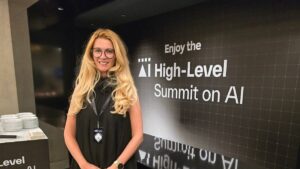Supercomputer Accelerated the Development of Eco-Friendly Hydrogen Production
Hydrogen is one of the key elements driving the transition toward sustainable energy. Its carbon-free production represents a cornerstone of the green energy future — from industry to transportation. However, finding an efficient and affordable way to produce it remains a scientific challenge that brings together chemistry, materials research, and computational modeling.
In this success story, we take a look at how Slovak researchers harnessed the computational power of the NSCC Slovakia supercomputer to accelerate the development of a cheaper and more eco-friendly catalyst for hydrogen production. By combining laboratory experiments with HPC simulations, they succeeded in understanding the behavior of atoms on the surface of a material that could one day replace expensive metals such as platinum.
This research demonstrates how High-Performance Computing (HPC) helps push the boundaries of scientific knowledge and supports the transition toward cleaner and more sustainable energy — right from Slovak laboratories.
Challenge: Hydrogen is increasingly seen as the “fuel of the future” — carbon-free, clean, and applicable across industry, energy, and transportation. However, to make it truly accessible, it must be produced more cheaply and efficiently. Traditionally, expensive metals such as platinum have been used for this purpose, but they are not suitable for large-scale deployment. Scientists are therefore searching for new materials capable of catalyzing (accelerating) the reaction through which hydrogen is released from water.
Solution: A team of researchers from the Institute of Chemistry at Pavol Jozef Šafárik University in Košice and the Institute of Materials Research of the Slovak Academy of Sciences focused on molybdenum phosphide (MoP) — an inexpensive and readily available material with the potential to replace costly metals. They studied how MoP performs in different environments — from acidic to alkaline — and why it is able to maintain its efficiency.
The laboratory alone was not enough. The reactions on the catalyst’s surface are extremely fast and occur at the atomic level. To truly understand them, it was necessary to combine experimental research with computational simulations on a supercomputer.
Use of HPC Infrastructure
Collaboration with NSCC Slovakia and the use of a supercomputer enabled the researchers to create computer models of the catalyst and simulate what happens when hydrogen atoms bind to its surface.
Thanks to HPC, the team was able to:
- uncover the reaction mechanism — how hydrogen atoms behave on the surface of MoP
- verify the stability of the material in different environments
- predict potential improvements to the catalyst even before it is produced in the laboratory.
Impact
The outcome is significant for several reasons:
- MoP is cheaper and more accessible than platinum, which could reduce the cost of hydrogen production.
- The material works across a wide range of environments, meaning it could be deployed in various types of electrolyzers worldwide.
- The combination of experiments and HPC simulations saves both time and costs — allowing researchers to identify the best solutions much faster.
This research shows that HPC is not just for physicists or computer scientists — it can also play a crucial role in advancing green energy. Thanks to the computational power of the supercomputer, Slovak researchers contributed to global knowledge on eco-friendly hydrogen production and paved the way for new technologies that can directly impact energy independence and sustainability.
 VICE and the Digital Twin at the Pre-Christmas Hydrogen Infoday 11 Dec - Dňa 10. decembra 2025 sme sa zúčastnili podujatia Predvianočný vodíkový Infoday v Bratislave. Súčasťou programu bola prezentácia VICE – Vertical Integrated Cyclic Energy, Hydrogen, vedená Laurie Farmerom a Luciou Malíčkovou.
VICE and the Digital Twin at the Pre-Christmas Hydrogen Infoday 11 Dec - Dňa 10. decembra 2025 sme sa zúčastnili podujatia Predvianočný vodíkový Infoday v Bratislave. Súčasťou programu bola prezentácia VICE – Vertical Integrated Cyclic Energy, Hydrogen, vedená Laurie Farmerom a Luciou Malíčkovou.  Strengthening Slovak–Romanian Cooperation and the Development of Scientific Partnership 8 Dec - Romania’s National Day is a significant historical milestone commemorating the Great Union of 1918, when Transylvania, Bessarabia, and Bukovina united with the Kingdom of Romania. This moment laid the foundations of the modern Romanian state and remains a powerful symbol of national identity and unity to this day.
Strengthening Slovak–Romanian Cooperation and the Development of Scientific Partnership 8 Dec - Romania’s National Day is a significant historical milestone commemorating the Great Union of 1918, when Transylvania, Bessarabia, and Bukovina united with the Kingdom of Romania. This moment laid the foundations of the modern Romanian state and remains a powerful symbol of national identity and unity to this day. We Participated in the High-Level Summit on AI in Bratislava 2 Dec -
Zučastnili sme sa prestížneho High-Level Summit on AI – BratislavAI Forum 2025, ktorý predstavuje jeden z najvýznamnejších aktuálnych európskych príspevkov k formovaniu globálnej architektúry správy umelej inteligencie. Lucia Malíčková reprezentovala naše odborné kapacity v oblasti umelej inteligencie, dátových ekosystémov a digitálnych inovácií.
We Participated in the High-Level Summit on AI in Bratislava 2 Dec -
Zučastnili sme sa prestížneho High-Level Summit on AI – BratislavAI Forum 2025, ktorý predstavuje jeden z najvýznamnejších aktuálnych európskych príspevkov k formovaniu globálnej architektúry správy umelej inteligencie. Lucia Malíčková reprezentovala naše odborné kapacity v oblasti umelej inteligencie, dátových ekosystémov a digitálnych inovácií.
